| The Ten Coolest Spiders - Part Two |
| #4 - The Anglers |
Though related to the famous Orb Weavers (who construct the "iconic" web shape),
the Mastophora, also known as "bolas" or "fishing" spiders, construct no web at all, but
dangle a dense, sticky globule from a single strand of silk. This "fishing line" comes
complete with a lure: each species imitates the pheremones of a different moth,
behaving exactly like a female moth by lying in wait for the male to catch its scent.
When the prey flies close, the spider swings its bolas with astonishing aim.
Not only do these spiders use scent to fool their prey, but use visual mimicry to fool
their own predators, closely resembling bits of vegetation, bird droppings or even snail
shells while they rest in plain sight.
the Mastophora, also known as "bolas" or "fishing" spiders, construct no web at all, but
dangle a dense, sticky globule from a single strand of silk. This "fishing line" comes
complete with a lure: each species imitates the pheremones of a different moth,
behaving exactly like a female moth by lying in wait for the male to catch its scent.
When the prey flies close, the spider swings its bolas with astonishing aim.
Not only do these spiders use scent to fool their prey, but use visual mimicry to fool
their own predators, closely resembling bits of vegetation, bird droppings or even snail
shells while they rest in plain sight.
| #5 - The (almost) Vegans |
While the rest of Aranea have been observed only rarely dining on plant materials, the
jumping spider Bagheera kiplingi (named in honor of the Jungle Book, for whatever
reason) exhibits a predominantly herbivorous lifestyle. Living alongside acacia ants in
Mexico (see this article), more than 90% of this spider's observed diet consists of
food produced by the plant for its ant partners, only occasionally preying upon ant
larvae or other prey during the drier seasons. In Costa Rica, where the acacia is less
common, this same species is more actively predacious, though a substantial part of
its diet is still derived from vegetation. Their cellular makeup even demonstrates the
isotopic qualities of a true herbivore more than a carnivore.
jumping spider Bagheera kiplingi (named in honor of the Jungle Book, for whatever
reason) exhibits a predominantly herbivorous lifestyle. Living alongside acacia ants in
Mexico (see this article), more than 90% of this spider's observed diet consists of
food produced by the plant for its ant partners, only occasionally preying upon ant
larvae or other prey during the drier seasons. In Costa Rica, where the acacia is less
common, this same species is more actively predacious, though a substantial part of
its diet is still derived from vegetation. Their cellular makeup even demonstrates the
isotopic qualities of a true herbivore more than a carnivore.
| #3 - The Diver |
Argyroneta aquatica, the "diving bell spider," is the one and only member of the
Argyroneta genus and the only known spider adapted to an aquatic environment. Like
diving beetles and several other aquatic arthropods, it breathes underwater by
trapping a thin layer of air against its body, held in place by specialized hairs. Going
one step further, it releases collected air into a dense, bell-shaped web to create a
large bubble in which it rests, feeds and rears its young, returning to the surface only
when its oxygen supply needs replenishing.
Argyroneta genus and the only known spider adapted to an aquatic environment. Like
diving beetles and several other aquatic arthropods, it breathes underwater by
trapping a thin layer of air against its body, held in place by specialized hairs. Going
one step further, it releases collected air into a dense, bell-shaped web to create a
large bubble in which it rests, feeds and rears its young, returning to the surface only
when its oxygen supply needs replenishing.
| #2 - The Vampire's Vampires |
Evarcha culicivora, native to East Africa, is the first spider ever discovered to require
the blood of large vertebrates in its diet. Unfortunately for this would-be parasite, its
tiny, hooked fangs are like those of any other spider; equipped more for preying upon
small insects than for penetrating flesh. To sate its unusual hunger, this spider tracks
down a female mosquito - bloated on her last meal - and drains blood directly from the
insect's stomach.
the blood of large vertebrates in its diet. Unfortunately for this would-be parasite, its
tiny, hooked fangs are like those of any other spider; equipped more for preying upon
small insects than for penetrating flesh. To sate its unusual hunger, this spider tracks
down a female mosquito - bloated on her last meal - and drains blood directly from the
insect's stomach.
| #1 - The "Porsche" of Spiders |
If you're an arachnophobe, (congratulations on reading this far) jumping spiders of the
Portia genus (indeed named for the sports car) are either your best friend or worst
nightmare. Considered the most measurably "intelligent" and among the most highly
evolved of all arachnids, these amazing creatures prey almost exclusively upon other,
often far larger spiders, and employ a wide variety of hunting techniques to overcome
such formidable food; techniques that the same individual chooses and even modifies
depending on its prey. While millions of other predators have repeated the same
behavior to obtain the same food for thousands of years at a time, a spider with fewer
brain cells than a honeybee has learned to formulate a unique course of action for
each new situation.
Against one spider, a Portia may imitate the movements of an insect caught in their
web. Against another, the same Portia may replicate the complex mating dance of the
victim's species. They memorize every encounter, visually identify the species of their
prey and pick whatever method was successful in the past. Faced with a new species,
they test different actions, gauge the prey's reaction and determine the best strategy
through trial and error...possibly devising a course no other Portia may ever fully
duplicate.
Portia genus (indeed named for the sports car) are either your best friend or worst
nightmare. Considered the most measurably "intelligent" and among the most highly
evolved of all arachnids, these amazing creatures prey almost exclusively upon other,
often far larger spiders, and employ a wide variety of hunting techniques to overcome
such formidable food; techniques that the same individual chooses and even modifies
depending on its prey. While millions of other predators have repeated the same
behavior to obtain the same food for thousands of years at a time, a spider with fewer
brain cells than a honeybee has learned to formulate a unique course of action for
each new situation.
Against one spider, a Portia may imitate the movements of an insect caught in their
web. Against another, the same Portia may replicate the complex mating dance of the
victim's species. They memorize every encounter, visually identify the species of their
prey and pick whatever method was successful in the past. Faced with a new species,
they test different actions, gauge the prey's reaction and determine the best strategy
through trial and error...possibly devising a course no other Portia may ever fully
duplicate.
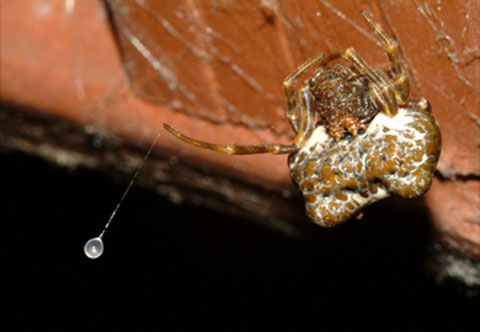
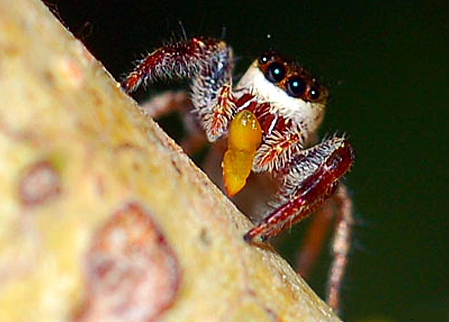
Continued from part one, it's a countdown of the ten most remarkable
eight-limbed animals this side of a cephalopod!
eight-limbed animals this side of a cephalopod!
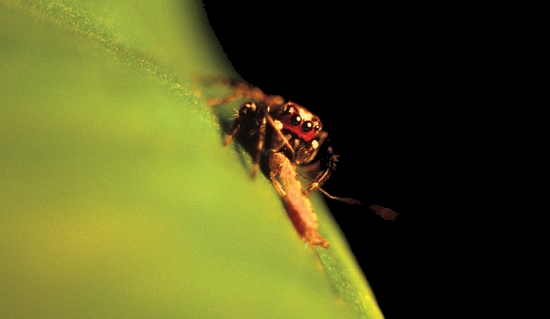
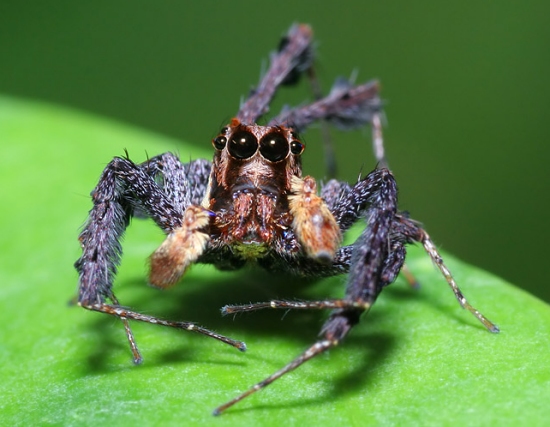
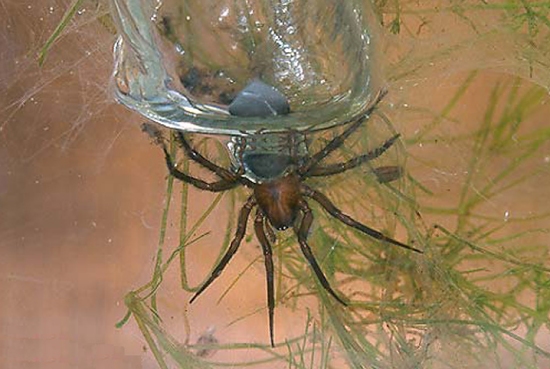
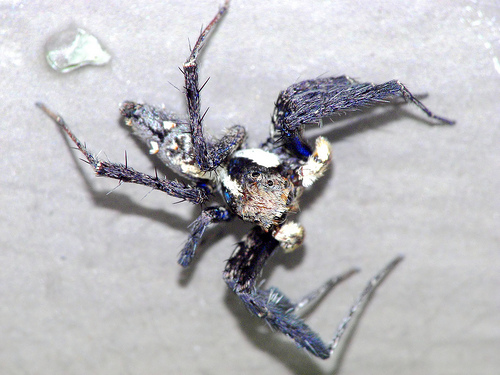
Portia have been observed constructing small webs of their own, but these are
usually attached to the webs of larger spiders. When an insect gets caught in this
addition, the Portia is actually using it as bait for the other arachnid. Some are also
known to hunt the spitting spiders described on our previous page, and prefer to
target mothers who are unable to spit while they carry eggs or young in their jaws.
Against active hunters such as other jumping spiders, they behave like a dead leaf
and move only with the breeze.
The more they are studied, the more these tiny schemers - and many other spiders -
continue to surprise us.
usually attached to the webs of larger spiders. When an insect gets caught in this
addition, the Portia is actually using it as bait for the other arachnid. Some are also
known to hunt the spitting spiders described on our previous page, and prefer to
target mothers who are unable to spit while they carry eggs or young in their jaws.
Against active hunters such as other jumping spiders, they behave like a dead leaf
and move only with the breeze.
The more they are studied, the more these tiny schemers - and many other spiders -
continue to surprise us.
| Written by Jonathan C. Wojcik - Photo credits unknown or from public news outlets. |
| Photo by Charles Lam |